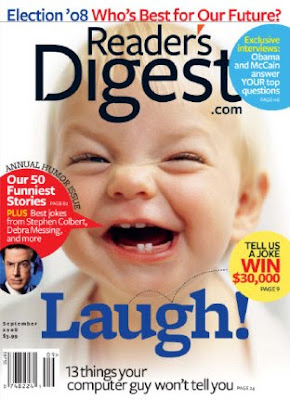Search: readers digest waiting in line jockeying
Why: To show Brian, who said people don't often line up in Korea. I read about "queueing theory" in Reader's Digest last weekend when I was riding on an airplane.
(In case you don't know this about Reader's Digest, it is the perfect accessory for air travel: compact enough to fit in your carry-on, dense enough to entertain you for up to 3.5 hours. Get a subscription today!)
Answer: Here is the text of the article (by Tarah Knaresboro from Popular Mechanics.) It's pretty short:
Also, according to resident advice-giver Jeanne Laskas, it is poor etiquette (and unnecessary) to have a friend or family member stand in one line while you wait in another in case one moves more quickly. Very rude indeed.Everything You Need to Know About Surviving a Line
Waiting in line is a universally despised experience, but scientists around the world are dedicated to making it less odious. In June, Taiwanese researcher Pen-Yuan Liao published an equation that predicts when a customer will avoid a line if he feels it’s too long. Liao’s formula calculates the expected length of a line and the mean arrival rate to determine the number of customers who will retreat. His research, intended to inform stores’ staffing needs, represents only one niche in the growing field of queueing theory.
The owners of corporations, amusement parks, banks, and fast-food chains can scan the monthly journal Queueing Systems: Theory and Applications for trends that suit their clientele. “There’s no such thing as the perfect line,” says MIT queueing theorist Richard Larson. “The trick is to convince people they’re being treated fairly.” Many people’s aversion stems from bad design, Larson says. “Some large companies don’t even know the kindergarten basics.”
But now you do. Start with the line lexicon:
Jockeying: The act of switching to a parallel line.
Faffing: The time delay when a person gathers his things after paying at checkout—an average of 3.17 seconds.
Reneging: A customer leaves a queue he believes he has spent too much time waiting in.
Balking Index: An equation that predicts when someone will turn away from a long line.
First In, First Out: The principle stating that the person who has waited the longest will be served first.
6 Qualities of Queueing Up
- Customers waiting in parallel lines jockey, feeling sure the other line is faster.
- Distractions, such as TVs and smartphones, shorten perception of time.
- Without signs displaying wait time, people overestimate it by 23 percent.
- The more people waiting behind a customer in line, the less likely that person is to renege.
- Lines surrounded by lavender scent tend to be less annoying.
- Serpentine lines look longer, increasing balking loss, but people feel they are more fair.
Source: RD.com
The More You Know: The word "queue" comes from the French word for "tail." In the 1700s, a "queue" was a braid of hair.








